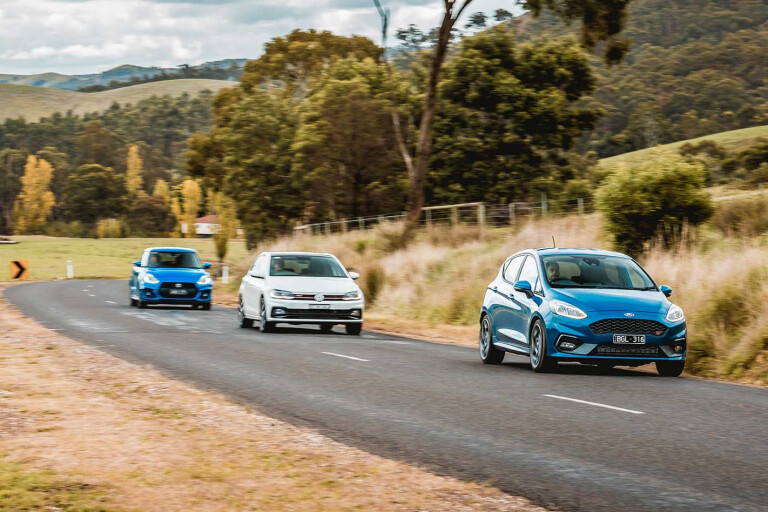
It’s safe to say that 2020 is a year Marty McFly would never input into a time machine. Right now, the world is in desperate need of a bit of fun and if any new-car segment is ripe for the challenge, it’s the diminutive hot hatch class. Its remit is to excite and delight in all facets, whether you’re grimly hanging on at ten-tenths or hanging on grimly to the last bottle of hand sanitiser on your way home from Coles. This trio, then, could be the perfect antidote to the doom and gloom.
If you’re going to be so fashionably late that you almost miss the entire party, then you had better bring the goods. Luckily for Ford Australia, the $32,290 Fiesta ST does just that and more. Wheels first drove this second-generation car on European roads two years ago, so the waiting game has been a long one for Aussies. But at least it has all the ingredients for success; a thrummy three-cylinder turbo with 147kW/290Nm, a trick mechanical limited-slip differentual and a six-speed manual.

We’re pitting it against the ‘honey I shrunk the Golf’ Mk6 Polo GTI. Now flush with MQB underpinnings, the $32,490 Volkswagen is the most expensive of this trio by a few hundred dollars, but factor in the $7300 worth of options fitted to our test car and that number blows out significantly. Still, it feels premium thanks to a beautifully appointed and tech-rich cabin, and its proven EA888 2.0-litre boasts the highest outputs at 147kW/320Nm. A six-speed dual-clutch is the only gearbox available Down Under.
At $25,490 the Suzuki Swift Sport is a whopping 20 percent less expensive than the Ford and VW. And with ‘only’ 103kW and 230Nm to play with from its 1.4-litre turbo, it might seem a surprise inclusion. However, while it lacks the firepower of the other two, the plucky Swift (here in manual guise) weighs only 970kg, meaning its power-to-weight ratio isn’t as far behind as you might expect. It could very well spring a surprise.
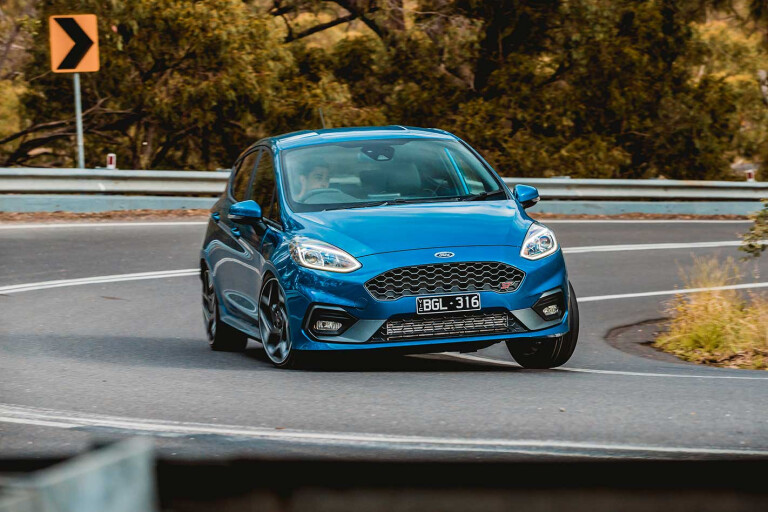
It’s no secret we’re fans of the Fiesta ST here at Wheels. To date our road test experiences have been remarkably positive, though editor Inwood stresses that fresh eyes need to be instated. This comparison is far from a foregone conclusion.
Our test loop is short and sweet, but one section in particular is brilliant. It comprises an almost 90-degree right-hander before a short uphill shoot where you can either bung it on redline in second or shift into third before a heavy heel-and-toe downshift in the manuals. At that point you arrive at a technical left-hand hairpin; one that coaxes you into braking as late as possible given it opens up past the apex as the gradient significantly ascends. Thereafter the climb continues into a fast left before a right-hand hairpin. It certainly highlights any dynamic flaws.
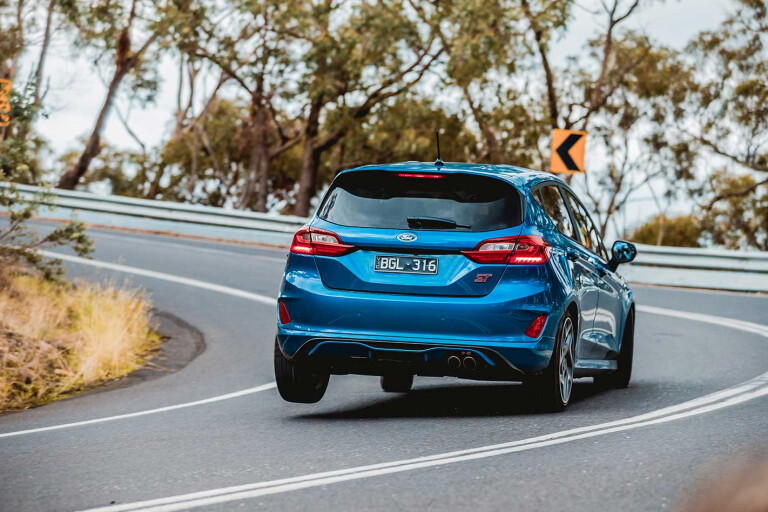
Spoiler alert, the Fiesta shines. It has a level of intent and competence that outstrips the competition here. Barrelling into the first left-hand hairpin with ambitious pace sends all the weight to the outside front, meaning the ST cocks its inside rear wheel like a crazed canine that’s finally been let off the leash. Go in too hot and it will push, but the threshold is high and you can feel the Quaife LSD driving the outside Michelin Pilot Sport 4 (205-section) out of the corner.
The highly developed twist-beam rear suspension and force-vectoring ‘banana’ springs have added control to the traditionally playful ST rear axle, but it hasn’t forgotten how to oversteer. The quick steering and confidence-inspiring front-end help when you feel like wagging the tail, and the rear-end now breaks away with greater progression than the old ST. There’s a new-found sense of maturity to the ride quality, too, with the mono-tube dampers rendering an adaptive setup largely unnecessary. It’s firm but controlled, resulting in a set-up that’s bearable for daily use.

While the VW’s fun factor is never quite turned up to 11 like the Ford, the GTI is often harshly branded as a bit too dull. You just have to search harder within the layers of its refined persona to find its joie de vivre. Get the GTI onto its toes and it’s an engaging thing, and its punchy 2.0-litre ensures it covers ground at a surprisingly rapid rate. However, the un-killable electronic nannies are annoying, with the sometimes over-eager ESC and traction control calibration combining to cut power to the 215/40 Bridgestone Turanza front hoops. And through the left-hand hairpin, the GTI’s electronic braking system can’t fake the effectiveness of the ST’s fully mechanical unit.
The ride quality is impressive, though, thanks to adaptive dampers which are now included as standard. In Comfort mode the VW isn’t as restless as the Ford over broken surfaces, endowing the Polo with an effortless cross-country cruising vibe. The steering isn’t as quick either, and while it might lack the Ford’s tactility and connection, its lighter weighting and level of fluidity are appreciated when you just want to cruise to the shops. The Polo doesn’t always feel ‘on’ like the Fiesta can, and its duality of character will please some buyers more. Yet, when the red mist descends, it lacks that final sharpened edge.
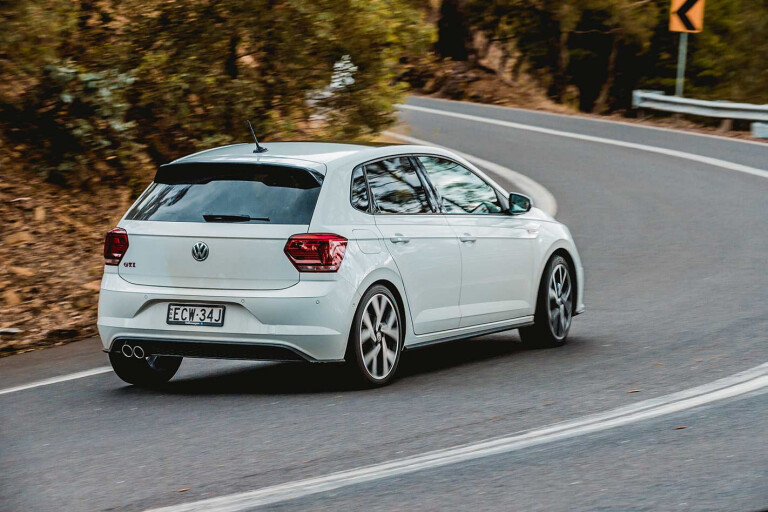
Still, the level of polish and competence VW has injected into the Polo is remarkable. It feels a notch above the Ford when it comes to perceived quality, and a gulf beyond what you find in the Suzuki. The problem the Swift faces is that, in isolation, the Sport is a fantastic $25K hatch with accessible performance. But put it up against two more expensive and talented players and there’s no escaping it feels out of its depth. Through the demanding left-hand hairpin the narrow 195-section inside front smokes up quicker than an unattended barbie despite the grippy Continental ContiSportContact 5 rubber. The Swift’s body control isn’t as taut as the others, either.
However, like a 1.5-litre Mazda MX-5, there is a level of pitch and lateral movement that, once you learn how to work with it, can be hugely enjoyable. The ride quality, too, benefits from the softer fixed-rate set-up, and a balance that errs on comfort is appreciated within city limits. The steering does suffer some kickback under load, however, and while the travel of the brake pedal is progressive, it feels spongy and doesn’t inspire the same level of confidence during hard driving as the other two.

In terms of powertrains, the Fiesta might be down a cylinder compared to the others but it’s certainly not down on performance. In fact, it feels the strongest thanks to a torque-rich bottom end. We’ve managed 6.5 seconds to 100km/h previously, but it’s the meaty torque that surprises; this is a car that feels significantly quicker than its numbers suggest. The six-speed manual is decent, if not brilliant, thanks to short throws and nicely judged ratios that marry well with the 1.5-litre triple. And yes, it sounds mega. Close your eyes and squeeze your ears a little and those Porsche 911 dreams almost become a reality…
VW’s venerable EA888 2.0-litre means it can be difficult to remember you’re in a Polo and not a Golf, but that’s no bad thing. A previously tested 6.4 seconds to 100km/h is testament to its straight-line prowess and this application has its own character, too, with a subdued but pleasingly hearty soundtrack. There are even turbo whistles and muted pops on the overrun. Yet, revving the four-pot out to redline doesn’t offer a meaningful return, so shifting up early via the steering wheel-mounted paddle is the best option. And yes, the six-speed DSG is great on the run, but can still be confused at slow speeds.
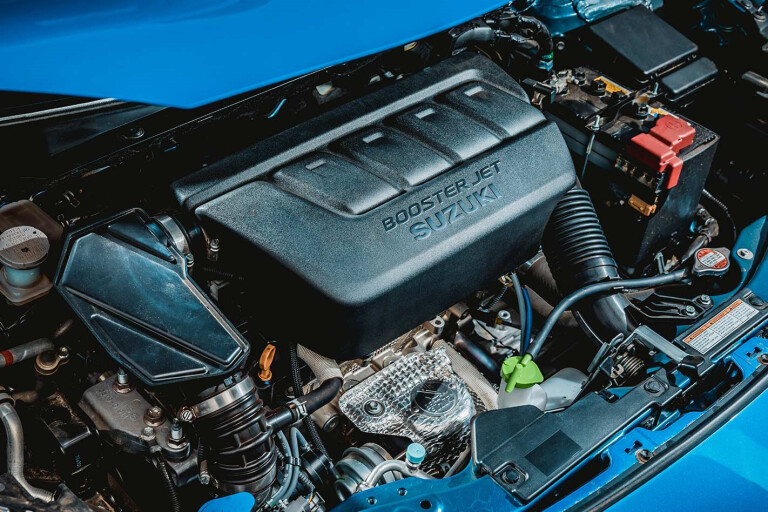
You’d think the Swift’s BoosterJet 1.4-litre turbo four-cylinder would be outgunned in this company. However, thanks to the lithe sub-tonne kerb weight (the Polo is 1285kg and the Fiesta 1208kg by comparison), the Sport feels pleasingly swift. There are no rorty exhaust or induction noises, however, and the party is definitely over by about 5000rpm, so there is little reason to search for the 6000rpm cut out. But the small turbo spools up early and it still feels quick, even though it will take you an extra 1.0sec or so to hit 100km/h. The benefit to the Swift’s small capacity and heft is a tested fuel consumption figure of 6.9L/100km, which is thriftier than the Polo’s 7.6 and Fiesta’s 8.4L/100km results.
However, the golden ticket for a small hot hatch doesn’t just lie in its ability to raise its leg on an apex. A hot hatch also has to be pragmatic. Thankfully the old Fiesta’s smartphone-style buttons have gone and the quality of the materials has risen for this new generation. The body-hugging Recaro bucket seats, with great side bolstering and comfort, have been lowered for a better driving position, while the thick-rimmed steering wheel is heated. The B&O sound system drowns out what road noise there is, but general NVH levels aren’t too high. Little guards pop out of the doors to prevent you causing dints, the rear seats fold in a 60/40 fashion and the boot is middle of the road at 311 litres.
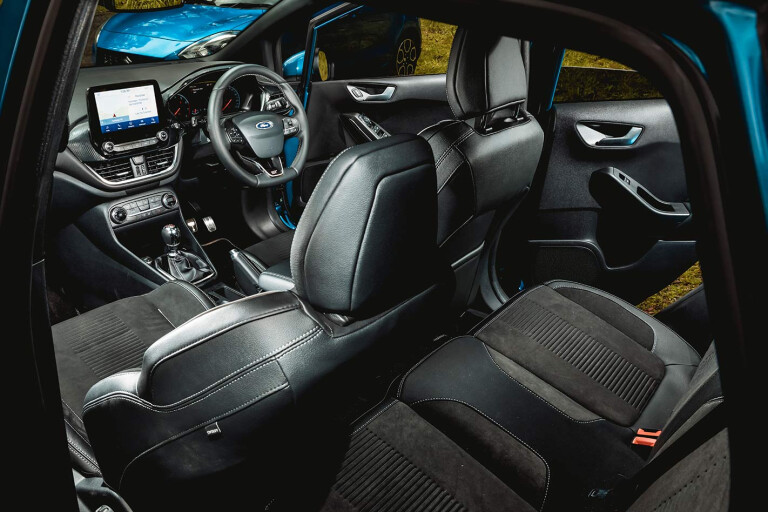
If the Fiesta hits the highest notes dynamically, it’s the Polo that wins for interior comfort and polish. It’s definitely head and shoulders above in terms of fit and finish, and while the optional digital instrument cluster is undoubtedly expensive at $1900 as part of the Sound and Vision pack, it’s money well spent if your budget can stretch that far. We’re less convinced by the comfort seats (part of the $3900 luxury package), which are a little too flat and lack lateral support. If you opt not to have the space-saver spare, the cargo capacity of the GTI is the biggest here at 351 litres – that shrinks to 305 litres with the fifth wheel. The Polo is the only one to offer dual rear USB charging points.
If the Swift is a step behind dynamically, it feels a class below inside. There’s no escaping this is a car based on a $16,990 budget hatch. Plastics are hard, the design isn’t as modern (there’s no digital speedo, though it is fitted to an imminent update), a lack of centre armrest grates and the road noise is the most intrusive. Yet it’s by far the roomiest. The Swift will easily accommodate four adults, though its boot is small-ish at 242L.Still, the Suzuki Swift Sport’s inclusion here is valid. It’s the cheeky runt of the trio that you just can’t help but love – and it’s a worthy choice if your budget can only stretch so far. It might be 20 percent less expensive than the others, but it’s certainly not 20 percent less car.
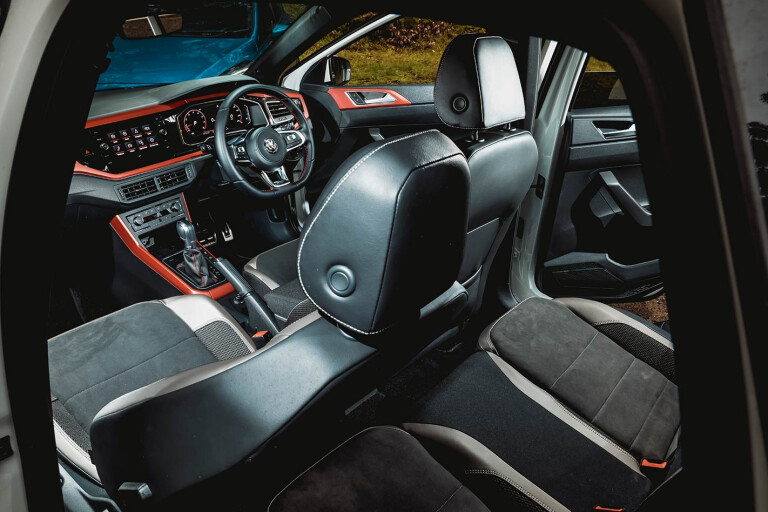
Which leaves the Polo and Focus. If duality of character is a high priority, then the Polo GTI is the grown-up that still knows how to party. And while it might be the most expensive, it’s also the most multi-talented of this trio. The chassis offers a sophisticated dynamic base and the EA888 four-pot delivers proficient punch, plus you’re ensconced in an almost Audi-style ambience. It’s a remarkably rounded performance hatch, but it’s missing something the feisty Ford has in droves – engagement.
For those with a more optimistic outlook, 2020 could be remembered as the year we finally got the Fiesta ST, not a global pandemic. Cars of this calibre are rare and although it lacks the final layer of polish you get in the VW, Ford has perfectly judged the trade off between performance and comfort. If you’re in the performance market, thrills don’t come much better than this. So yes, in uncertain times like these, the Fiesta ST is exactly the escape we all need.
ONE SIZE DOES NOT FIT ALL
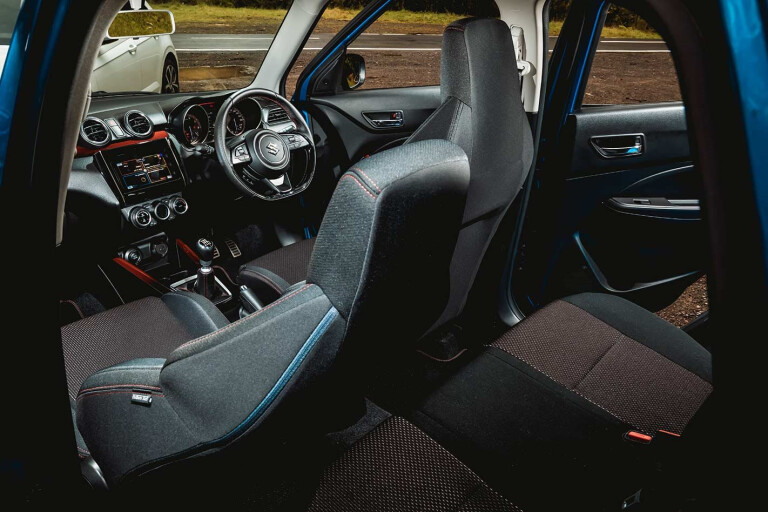
Swift is the shortest of the trio at 3890mm (Polo 4067mm, Fiesta 4068mm), but it easily has the roomiest rear seat (above). Headroom is also best in the little Suzuki. Fiesta has the tightest rear seat, though the cushions are excellent. All three lack a middle arm rest and rear air vents.
PAYING FOR UPGRADES

The Volkswagen Polo GTI offers the best in-car tech and infotainment, but there is a caveat – to get the full digital experience you have to pay $1900 for the Sound and Vision pack which upgrades the conventional dials to a fully configurable 10.25-inch display. If the Polo’s infotainment is fast and intuitive, the Swift’s smaller 7.0-inch touchscreen is easily the laziest and is hard to see when wearing polarised sunglasses. The Fiesta sits in the middle; not as flashy as the Polo but SYNC3 is fast and logical to use. All three offer Apple CarPlay/Android Auto connectivity.
VERDICT:
- Ford Fiesta ST – 9.5/10
- Volkswagen Polo GTI – 8.5/10
- Suzuki Swift Sport – 7.5/10
FORD FIESTA ST SPECS
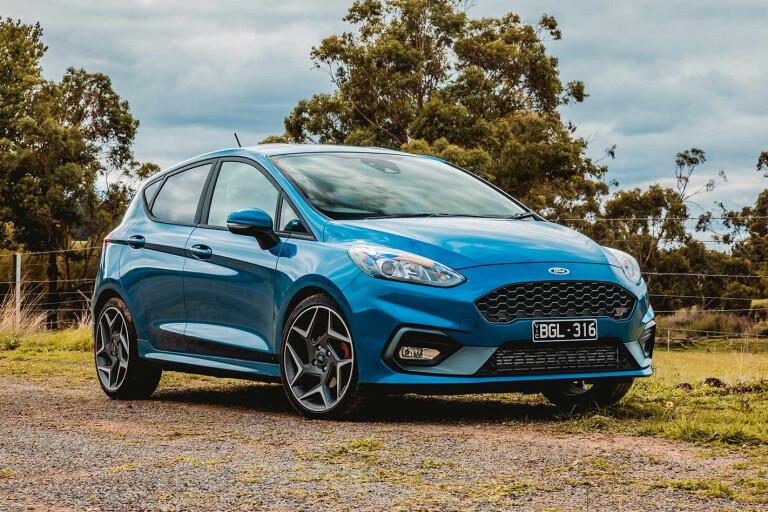
Price: $32,290 ($32,940* as tested)
Engine: in-line 3cyl, dohc, 12v, turbo
Layout: front engine (east-west), front drive
Capacity: 1497cc
Power: 147kW @ 6000rpm
Torque: 290Nm @ 1600-4000rpm
Gearbox: 6-speed manual
Body: steel, 5 doors, 5 seats
L/W/H/W–B: 4068/1783/1469/2493mm
Track (F/R): 1506/1476mm
Weight: 1208kg
Boot: 311 litres
Fuel/tank: 95 octane/42 litres
Economy: 8.4L/100km (test average)
Front suspension: struts, A-arms, coil springs, anti-roll bar
Rear suspension: torsion beam, coil springs, anti-roll bar
Steering: electric rack-and-pinion
Turning circle: 11.0m (1.9 turns lock-to-lock)
Front brakes: ventilated discs (278mm)
Rear brakes: solid discs (253mm)
Tyres: Michelin Pilot Sport 4
Tyre size: 205/40 R18
ANCAP rating: 5 stars
Warranty: 5yr/unlimited km
Service interval: 12 months/15,000km
Glass’s 3-year resale: N/A
AAMI Insurance: $1130.
*Options: Metallic paint ($650)
SUZUKI SWIFT SPORT SPECS

Price: $25,490 ($25,990* as tested)
Engine: in-line 4cyl, dohc, 16v, turbo
Layout: front engine (east-west), front drive
Capacity: 1373cc
Power: 103kW @ 5500rpm
Torque: 230Nm @ 2500-3000rpm
Gearbox: 6-speed manual
Body: steel, 5 doors, 5 seats
L/W/H/W-B: 3890/1735/1495/2450mm
Track (F/R): 1510/1510mm
Weight: 970kg
Boot: 242 litres
Fuel/tank: 95 octane/37 litres
Economy: 6.9L/100km (test average)
Front suspension: struts,A-arms, coil springs, anti-roll bar
Rear suspension: torsion beam, coil springs, anti-roll bar
Steering: electric rack-and-pinion
Turning circle: 10.2m (2.8 turns lock-to-lock)
Front brakes: ventilated discs (285mm)
Rear brakes: solid discs (252mm)
Tyres: Continental ContiSportContact5
Tyre size: 195/45 R17
ANCAP rating: 5 stars
Warranty: 5yr/unlimited km
Service interval: 6 months/10,000km
Glass’s 3-year resale: 55%.
AAMI Insurance: $819.
*Options: Metallic paint ($500)
VOLKSWAGEN POLO GTI SPECS
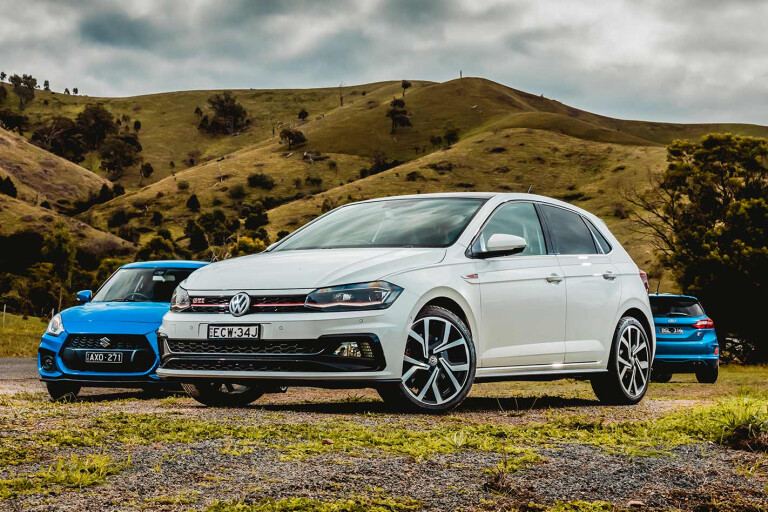
Price: $32,490 ($39,790* as tested)
Engine: in-line 4cyl, dohc, 16v, turbo
Layout: front engine (east-west), front drive
Capacity: 1984cc
Power: 147kW @ 4400-6000rpm
Torque: 320Nm @ 1500-4400rpm
Gearbox: 6-speed dual-clutch
Body: steel, 5 doors, 5 seats
L/W/H/W-B: 4067/1751/1438/2560mm
Track (F/R): 1510/1484mm
Weight: 1285kg
Boot: 305 litres
Fuel/tank: 95 octane/40 litres
Economy: 7.6L/100km (test average)
Front suspension: struts, A-arms, coil springs, adaptive dampers, anti-roll bar
Rear suspension: torsion beam, coil springs, adaptive dampers, anti-roll bar
Steering: electric rack-and-pinion
Turning circle: 10.6m (2.8 turns lock-to-lock)
Front brakes: ventilated discs (310mm)
Rear brakes: solid discs (272mm)
Tyres: Bridgestone Turanza T001
Tyre size: 215/40 R18
ANCAP safety: 5 stars
Warranty: 5yr/unlimited km
Service interval: 12 months/15,000km
Glass’s 3-year resale: 54%.
AAMI Insurance: $978.
*Options: Driver Assistance package ($1500), Sound and Vision package ($1900), Luxury package ($3900)

COMMENTS